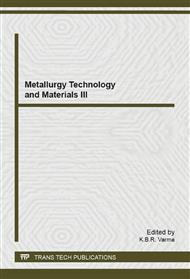p.168
p.173
p.180
p.185
p.190
p.194
p.198
p.202
p.206
Study on M5640 Extraction Copper from Ammoniac Leach Solution of Copper Oxidized Ore
Abstract:
The extractant M5640 that extracted and stripped copper in the ammonia leach solution of copper oxidized ores solution of were mainly studied for the experimentation examined the M5640 concentration, phase ratio, extraction time, and liquid pH. Laboratory Investigations indicated that M5640 is really an efficient copper extractant with a maximum extraction of as high as 99.64% under the conditions of 6.48g/L Cu in leach solution, the extraction agent concentration is 10%, phase ratio is 1:1, extraction time is 2 min and liquid pH was 9.58. The stripping can be conducted with the barren electrolyte as a stripping agent in which the sulfuric acid concentration remains about 150g/L, and a stripping rate of 99.80% is obtained.
Info:
Periodical:
Pages:
190-193
Citation:
Online since:
June 2014
Authors:
Keywords:
Price:
Сopyright:
© 2014 Trans Tech Publications Ltd. All Rights Reserved
Share:
Citation:


